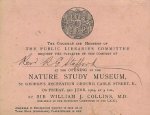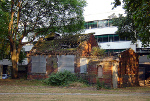
The mortuary chapel
In 1876, at the time that plans were being made to turn the
former churchyard into a public garden, the Vestry constructed a small
redbrick mortuary chapel on the south-eastern corner of the site. This
may have replaced a former building on this spot (though earlier maps
do not show one), or the mortuary in the adjacent Wesleyan burial
ground (shown on older maps), which was cleared and incorporated into
the Gardens. It was presumably built as a reminder of
the original function of the gardens, as well as for practical purposes.
Public
health concerns (from the time of the 1848 Public Health Act, and
reinforced by the 1866 Sanitary Act) prompted the building of such
chapels, for the repose of coffins prior to burial in the distant
public cemeteries that had replaced local churchyards, often involving
a greater time delay (plus the need for poor families to accumulate
burial fees). Keeping bodies for many days in overcrowded homes (in
rooms where the living were sleeping) called for action. Brooke
Lambert, Vicar of St Mark Whitechapel, was among those who campaigned
for chapels - see here for details. However, there was strong resistance from the urban classes, partly because of
domestic leave-taking customs, and fears about body-snatiching, and
partly because of objections from local residents concerned about the
'miasma' surrounding dead bodies (a legacy of the old insanitary burial
grounds). So urban mortuary chapels were little used. See further Pam
Fisher, Houses for the Dead (London Journal 34.1, March 2009), which refers specifically to the mortuary chapel at St George-in-the-East.
The Nature Study Museum
 In
1904 the disused mortuary was converted by the newly-created Borough
of Stepney into a Nature Study Centre and
Museum, a branch of the Whitechapel Museum. Over the door (still
visible) are the words Metropolitan Borough of Stepney Nature
Study Centre. This picture is from 1910.
The cost, met by an anonymous benefactor, was £253 1s 2d. [invitation to opening right].
In
1904 the disused mortuary was converted by the newly-created Borough
of Stepney into a Nature Study Centre and
Museum, a branch of the Whitechapel Museum. Over the door (still
visible) are the words Metropolitan Borough of Stepney Nature
Study Centre. This picture is from 1910.
The cost, met by an anonymous benefactor, was £253 1s 2d. [invitation to opening right].
The
vision came from the Curator of
the Stepney Borough Museum, Miss Kate Marion Hall and the then-curate
of the
parish, Claude Hinscliffe, who became the first secretary of the School
Nature Study Union, founded in 1902/3. Its journal was School Nature Study. Others involved in its foundation were Miss Lulham and Miss von Wyss of the London Day Training College. tI
was was an influential group in
the London area, and paved the way for
rural and environmental studies
(see further E.W. Jenkins & B.J. Swinnterton 'The School Nature
Study Union 1903-94' in the journal History of Education 1996, vol 25
no 2 pp181-98). Its national influence was more limited - though in 1906 the Finnish journal Vanamon Kirjastia
(vol 5) published an article 'Kuvia Englannin Koulista' on the nature
study work of Mr Winkworth from the neighbouring Cable Street School.
The
Union's motto was to see and to
admire, not harm
or destroy; they described the Stepney project as a Temple of Nature, in the least
romantic centre of the Metropolis.
The
intention was to
give city children and adults, who might otherwise never have
encountered live animals, an experience of the natural world. The
live exhibits included tanks of sea anemones, tropical and fresh water
fish and
amphibians (frogs, toads, newts and salamanders). So the Museum was
unique in London in two respects: it was the only one to major on live
exhibits, and Stepney was the first borough to support municipal
museums from the rates. The Linnaean Society's obituary of Miss Hall in
1919 described it as a fairy
house in an oasis.
There
were stuffed
birds, butterflies and moths. Outside there were wild flower gardens
(which, taking into
account the unfavourable local conditions of soil and atmosphere, is
surprisingly successful),
an ant-hive, an aviary, and a beehive, with glass walls, which could be
viewed from
within the Centre. The bees became famous: they fed on honey from the
garden flowers, syrup from shops, and spoil from the sugar ships at the
docks, and people came from far and wide to see them. Sadly, they were
removed during or after the First World War. Various specimen trees
were planted in the Gardens
at the time of its opening. A meteorological station, with regular
records, was kept.
 One of the children who visited wrote about 'Tom the borough
toad'....
One of the children who visited wrote about 'Tom the borough
toad'....
The Italian toad sits in a little pot of
water and hardly moves.
When we look at it, it makes a snap at us,
as if it wants to eat us.
 Up
to a thousand people
a day visited in the summer months, mostly local schoolchildren (it
was part of the Elementary Schools Curriculum), some of whom still
fondly remember their visits in the years before the War. They came in
school holidays too: according to the School Nature Study journal for
1916, sometimes
on those hot August afternoons, there were 70 in the room at a time,
till the curator would at last make a clean sweep of all who had not
only just come.
Up
to a thousand people
a day visited in the summer months, mostly local schoolchildren (it
was part of the Elementary Schools Curriculum), some of whom still
fondly remember their visits in the years before the War. They came in
school holidays too: according to the School Nature Study journal for
1916, sometimes
on those hot August afternoons, there were 70 in the room at a time,
till the curator would at last make a clean sweep of all who had not
only just come.
The Nature Study Museum managed to keep going during the First World War, but closed during the Second World War, since it proved impossible to acquire new live specimens, and many children had been evacuated. It never re-opened: the remaining specimens were transferred to the Whitechapel Museum, and the Centre fell into increasing disrepair and was subject to vandalism.

 Recent
years have seen several schemes and funding bids to restore and use the
building, but they have all failed. In the late 1990s a bid was made to
English Partnership for it to become a based for the City and Docklands
Gardening Company, training learning-disabled young people in
horticulture. In 2002 Spitalfields Trust obtained planning permission
for its restoration to something akin to its former purpose, on the
strength of which ownership was technically tranferred to the diocese
of London (with the 'effects of consecration' removed) to facilitate
this, but it foundered partly because it included an impractical
element of residential accommodation on the upper floor. At the time of
the major restoration of the Gardens in 2007-08, described here,
discussions took place with A Rocha, a Christian environmental
educational agency, as a centre for their work in East London, but this also came to nothing. The
Gardens were formally re-opened on 31 May 2009, with the absurdity of a
derelict building in its midst. There is an urgency to save it before
it is too late - it appears on the English Heritage Heritage at Risk register
- and we are currently exploring a project, in consort with the London
Borough of Tower Hamlets and the diocese, which we hope will come to
fruition.
Recent
years have seen several schemes and funding bids to restore and use the
building, but they have all failed. In the late 1990s a bid was made to
English Partnership for it to become a based for the City and Docklands
Gardening Company, training learning-disabled young people in
horticulture. In 2002 Spitalfields Trust obtained planning permission
for its restoration to something akin to its former purpose, on the
strength of which ownership was technically tranferred to the diocese
of London (with the 'effects of consecration' removed) to facilitate
this, but it foundered partly because it included an impractical
element of residential accommodation on the upper floor. At the time of
the major restoration of the Gardens in 2007-08, described here,
discussions took place with A Rocha, a Christian environmental
educational agency, as a centre for their work in East London, but this also came to nothing. The
Gardens were formally re-opened on 31 May 2009, with the absurdity of a
derelict building in its midst. There is an urgency to save it before
it is too late - it appears on the English Heritage Heritage at Risk register
- and we are currently exploring a project, in consort with the London
Borough of Tower Hamlets and the diocese, which we hope will come to
fruition.
Homepage | About Us | Services & Events
| Church &
Churchyard |
History